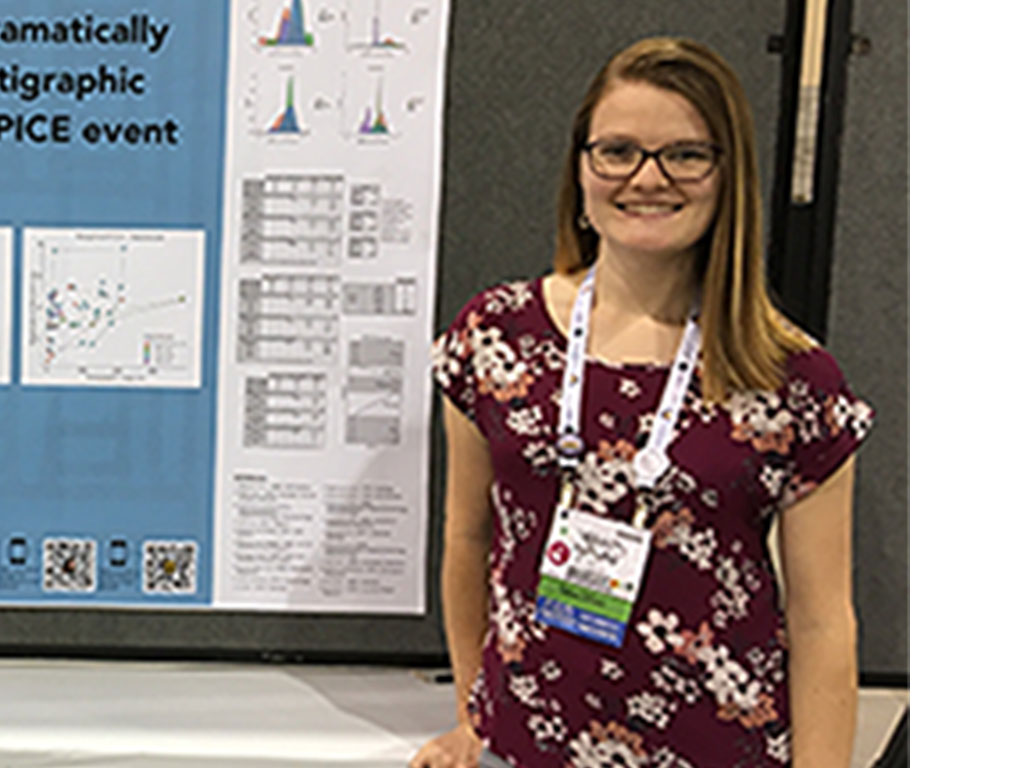From Master’s to PhD
This project, a continuation of Pulsipher’s master’s thesis, looks at carbon isotope records. In her master’s thesis, she compiled data from other published sources regarding a different carbon isotope excursion. This data compilation was then quantitatively evaluated to see how similar or different the data was in each record. Doing so allowed her to more rigorously evaluate what carbon isotope excursions can tell us about the paleoenvironment.
“So, for this scholarship, I’m going to do a very similar thing, but on a broader scale,” Pulsipher says. “Rather than look at one specific peak in the carbon isotope record, I’m going to look at an interval that captures a really important transition in geological time from the Precambrian into the Cambrian to think about how the Earth and life changed once we started the Cambrian explosion and began to see a lot more macroscopic complex life forms.”
As she explains it, sediments deposited into the ocean eventually turn into some of the rocks that one can see exposed on the Earth’s surface. She continues, adding the sediments that are accumulated have different ratios of specific elements, including one of the more important elements for life: carbon. There are multiple different types, or isotopes, of carbon atoms, which depends on the structure of the nucelus, she explains. Carbon 12, carbon 13, and carbon 14 are different carbon isotopes, which means they vary in the number of neutrons in the nucleus.
“You then can (measure and) compare the ratio of different types of carbon (in a rock)…. that’s your carbon isotope record. And that can tell us what the paleoenvironment was like because different environmental conditions will affect the isotopic ratio that had accumulated in the sediments.” For example, the amount of biological activity will affect the ratio as biological organisms prefer to use carbon 12.
“We’re going to look at the Shuram excursion, which is a carbon isotope excursion in the Ediacaran, that is temporally related to the rise of complex macroscopic life forms. And because we know our carbon isotope records can tell us about the paleoenvironment and biology, we want to get a more complete view of what the carbon isotope record at that time looks like on a global scale so we can better understand what the big picture is at the time these complex life forms are arising.”
New Era Dawns
Pulsipher says this work may help further divide the geologic time scale, which is important so that big chunks of time (called eras and periods) can be sliced into smaller, more precise intervals of time (called stages).
“It’s really close to where people are considering putting a new stage boundary,” she says. “So, a better understanding of the nature and timing of that excursion might help us define this lower-stage boundary that people want to put in the time scale.”
She adds the goal of her research is to quantitatively compare different records of carbon isotopes prior to, during, and after the Shuram excursion to better understand what they’re telling us regarding the bigger global picture.
“Most people have just been comparing (excursions) more qualitatively, looking at how the pattern of isotopes compares from one record to another.
“With my dissertation, I hope to take a whole bunch of records that we know are from the same event because of what the age of the rocks are, and what types of fossils there are,” she says. “I want to compare them quantitatively and think more about how they are similar or different, statistically. Is there a statistical, quantitative reason to correlate these different records? What do the (statistical) differences tell us about what was actually happening in the globe at that time?”
She says prior to her master’s project, nobody built a giant comprehensive data set of published carbon isotope records and evaluated them statistically. This project will allow her to build from that one.
“It will help give us a better context for the excursion itself and also think more about the bigger picture geology and paleontology changes related to the excursion,” Pulsipher adds. “I’m really excited about the research we are doing.”
Thanking Others
She says two professors have really inspired her in her work. Her advisors: Dr. Carol M. Dehler, at Utah State University; and Dr. James D. Schiffbauer at the University of Missouri.
“Carol helped me learn to embrace geology as a field of study that I could pursue and be my future and my academic career,” Pulsipher recalls. “She was really helpful in mentoring me in terms of academic success: How to build a CV and how to write an application and how to write an academic paper and everything that goes into doing work that gets published.
“And Jim here at Mizzou is very similar to Carol in terms of the things that I’m learning – things like how to be a better student and scientist, how to set myself up for success in my future, how to improve my CV or how to write scholarship applications and grant applications and how to write papers. He really values me as a person and is there in my corner to support me in whatever endeavors I want to pursue in my academic and personal life.
“And they’re both big reasons why I am the person I am today in terms of academia, and also my personal life: giving me confidence and the feeling I can accomplish the things I would like in my professional life.”



